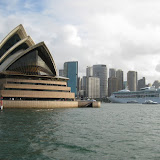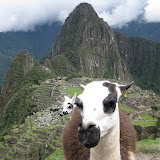 That's not ice. That's a missive layer of salt, stretching in every direction. Same kind of salt you find in the ocean, the Great Salt Lake, or used liberally in almost all Bolivian food.
That's not ice. That's a missive layer of salt, stretching in every direction. Same kind of salt you find in the ocean, the Great Salt Lake, or used liberally in almost all Bolivian food.Still feeling a bit congested, I figured a three day jeep tour into a 5000 m high desert might do the trick to dry out the sinuses a bit. So I went to the Salar de Uyuni in a dilapidated Toyota 4Runner with two Argentinian politicians, a daughter of one of them, three other backpackers (two from Bavaria, one from Minnesota), and hard-of-hearing guide/driver/cook with a mangled right ear who stuffed fist-sized wads of coca leaves in his mouth to stay awake.
We weren't one of the lucky groups that got to see the Salar after it rains. It's a very flat surface which, after rain, turns into a gigantic mirror that you can walk and drive on. When dry, it looks like what you see to the left. Because of the flat white expanse, it turns into one of the world's best places for trick photography. Search around the web and you can find some great shots. Like this one. We even tried a hand at it ourselves, though the results were less than perfect given we had only five minutes at the time and our driver was honking his horn at us so we'd get back to the car.
Looking around, if you took the same artist god metaphor from a couple posts back, all you could think of is that he just decided he didn't like this massive piece of land and took a gigantic eraser to the thing, leaving flat white cracked nothingness in its wake, dotted with islands with some of the biggest and oldest cacti in the world (one purportedly more than 1,200 years old). Just plain bizarre.
After that, even the surrounding desert looked like it was lush and full of life, just from the scrub, occasional quinoa fields, and wandering llamas. We drove from rocks to flamingo filled oasis lakes, to more rocks, and saw bizarre mineral effects, like the Laguna Colorado, a lake that's a dirty pink color instead of blue in the middle, and surrounded by steaming geysers.
The geysers we got to visit up close on our way to bathing in thermal waters at dawn on the last day. It was freezing at night in the desert, but as Drew, the backpacker from Minnesota pointed out, all the two of us had to do was remember what it was like back in the Midwest right now and we would be right at home. Still didn't stop me from being impressed when my swimsuit, towel, and even my hair all froze a few minutes after getting out of the hot spring. But relaxing in steaming water a few yards away from white and pink flamingos dunking their heads to stay warm in the face of the sunrise isn't something I'm going to forget.
It was a long drive back to Uyuni that day, and the semi-functioning tape deck was blasting Bolivian cumbia all the way. Cumbia is a kind of music my guidebook describes as sounding like a "three legged horse." It's from Colombia originally, and I've tended to like the versions I've heard from there on North. But for some reason, the further south you go, it seems to deteriorate somehow, until you get the music made up of an old Casio keyboard, a singer who can't stay on key, a drum that's just slightly off rhythm and these random shout-outs like you'd hear in American rap music. I've gotten a little tired of it.
The trains out of town were full, so everyone was going on the rickety buses running on dirt roads to get south. I got on mine, found my seat to be the middle seat of the very back, at the end of the aisle. The seat ahead of me and to my right was taken by a mother and baby. Then, when the cumbia started blasting and window-rattling decibels, as it sometimes does on these buses, I realized that I was seated directly under the only speaker. I looked around me and found the other passengers reacting the same way I felt. So I calmly took off my fleece and stuffed it into the uncovered speaker (to cheers and claps on the back).
As we went along the road, I had leg room, I made faces at the baby to keep it amused and most importantly, not crying until it fell asleep. The road was rough enough that the rattling obliterated what you could still hear of the music through my fleece, and I spent the rest of the time chatting up my Brazillian and Argentinian row-mates in a mix of Portuguese-tinted-Spanish and English. If anything has made me feel like a veteran Latin America backpacker so far, that ride was it.
We crossed into Argentina. I think I'm in a whole different world. A day or two ago I was looking at this. Now I'm looking at this. Everything is bigger, cleaner, and nicer. I'll have much more on all the differences soon. I'm in the city of Salta and getting on an overnight bus to Buenos Aires soon. I took a little turn around town and noticed something on the map. A square with a date for a name. Pretty common here, often things are named after the dates of saints days. I walked into the tourist office and asked about it.
"Hey, I'm curious about this square, what's the date signify?"
"What?"
"The date-- it's my birthday. Is it also a saints' day?"
"Oh wow! No, that's Argentine independence day!"
...this country and I have the same birthday. I think this might be a good match for me.
--
Check out this entry's Photos.








I imagine the wind that comes whipping off the salt flats is unpleasant. Did you have to wear goggles?
ReplyDeleteActually, the salt is a crystalized layer-- not a layer of table salt. If a chunk of it blew up with the wind, you'd need a lot more than just goggles to protect you (haven't seen that happen though).
ReplyDelete